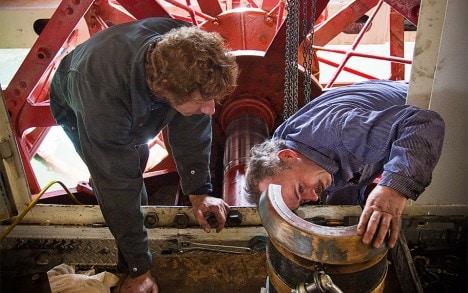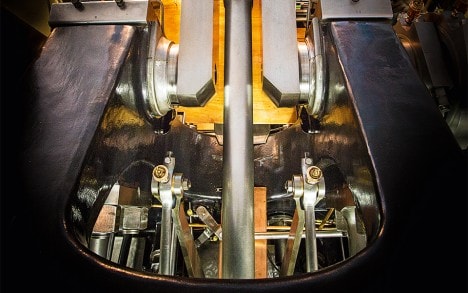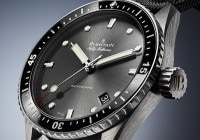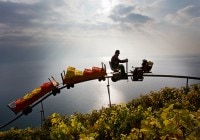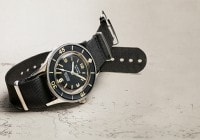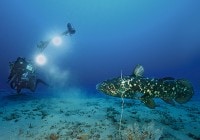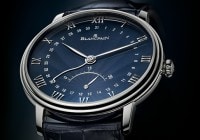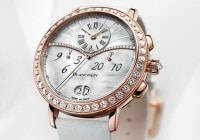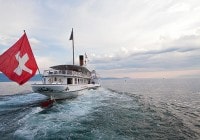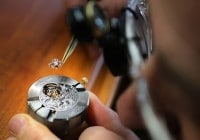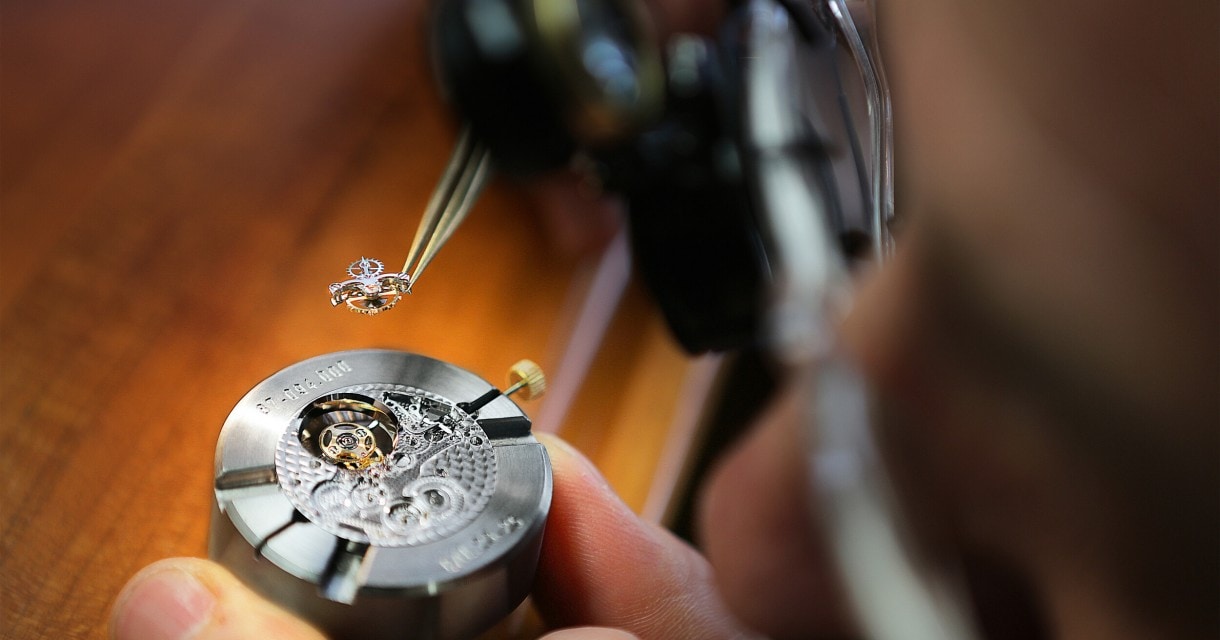
Search in Issues
Chapters
List of parts
Chapter 8
THE STEAMERS of Western Europe’s largest natural lake
Steamboats sailing Lake Léman for over a century.

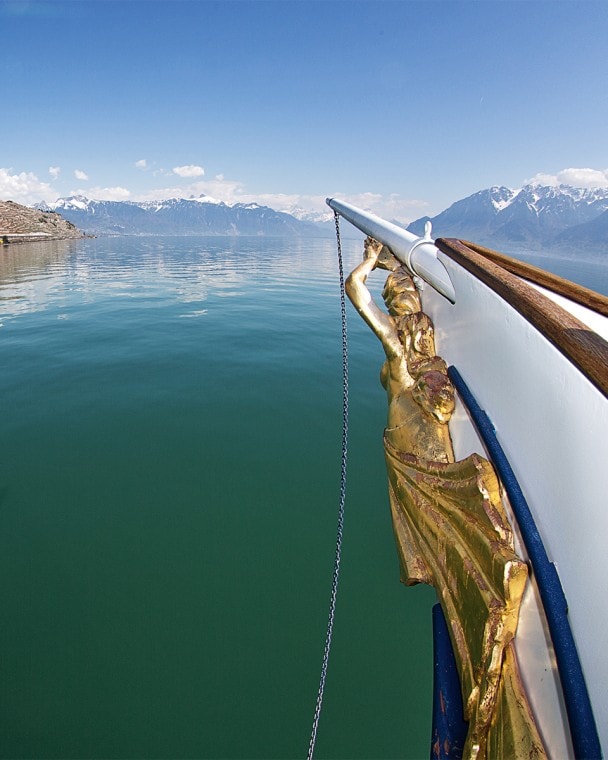
The figurehead of La Suisse was rebuilt in 2003 by Emmanuel Bourgeau, marine sculptor based in Brittany.
IT TAKES TIME to learn the secrets of navigating this lake.
All these people lived or still live on the shores of Lake Geneva, in Switzerland or France. They have all had the good fortune to admire the beautiful steamers that have plied the lake for 190 years.
“Always clockwise!” says the man in overalls who is teaching three boatmen in training how to coil a mooring line. As I approach to take a picture, he introduces himself: “Chenaux.” Frankly, I never imagined that this is how I would meet the First Captain, the “admiral” of the Lake Geneva General Navigation Company (CGN).
The man who heads the fleet of 16 boats (150 to 1,200 passenger capacity) is modest. Like Switzerland itself, perhaps, where it is not uncommon to come across a government minister walking home with his groceries in Bern, the capital.
Olivier Chenaux joined the CGN as an apprentice painter at age 17, and climbed the ladder rung by rung until he obtained his current rank in 1997. On average, it takes about fifteen years to become a captain on Lake Geneva. Many years of experience are needed to learn the secrets of navigating the lake, which despite its beauty can be quite treacherous. Then it takes another three years to rise from Second Captain, authorized to pilot diesel-powered ships, to First Captain, a level that provides access to the “holy grail”: the right to command one of the five Belle Époque steamers on Lake Geneva. We are going to hear about this experience from First Captain Chenaux and his predecessor, First Captain Aldo Heymoz, who held the position for 20 years.
But before that, we need to understand the unique character of these paddle steamers that are part of Lake Geneva’s heritage.
The boats are charming not just because of their steam engines, but also their paddle wheels, which churn powerfully through the water to propel the craft along. Some ships have a wheel at the back (sternwheelers)—like the famous Mississippi riverboats—while others possess two side wheels (sidewheelers), like those of Lake Geneva.
There are only about 50 seaworthy historic paddle steamers left in the world today, 19 of which are in Switzerland: 8 on Lake Geneva and 5 on Lake Lucerne, with the rest on the lakes of Zurich (2) Thun (1), Brienz (1), Constance (1) and Greifen (1). The fleet of Lake Geneva steamers, the largest in the world in terms of passengers carried, can be considered part of mankind’s patrimony. If UNESCO added a category for movable heritage, there is no doubt that these boats would be included—and that certain watchmaking creations would also be on the list.
The first steamboat on Lake Geneva carried a hundred passengers in 1823. Our eight beautiful boats with two decks and a lounge restaurant can each accommodate 550 to 850 people. They come from
THE HISTORY OF THESE VESSELS is also the history of the men who are one with their machines and who work together in a strong spirit of solidarity.
the golden age of Swiss tourism, i.e., the Belle Époque and the Roaring Twenties. From the inauguration of the first boat in 1875 (like others, it has disappeared since) and the last one in 1927, they continue to provide the carefreeness of the open lake and the delights of the Alpine landscapes that tourists came seeking at the time.
Although here we are extolling the eight paddle steamers of the CGN, we should also include a ninth boat that still floats on Lake Geneva, the Genève. Decommissioned in 1974 due to its age, it was bought by a Geneva association to serve people in need. This is a happy vocation for this steamboat, alleviating the memory of the tragic fate that struck Sissi, Empress of Austria, on September 10, 1898, as she was about to board it.
The Venoge is another boat of the period to appear in the annals of history. Built in 1905 to transport freight, it was the first ship in the world to be equipped with a diesel engine. Though it was replaced in 1924, the small Venoge (37 m) is still sailing on the lake, available for private cruises like its eight big brothers (64 to 78 m) of the CGN, which in the summer also provide regular service.
And what are these eight titans called? Seven are named after places: S/S Montreux (the eldest, commissioned in 1904), M/S Vevey, M/S Italie II (second of that name), S/S La Suisse, S/S Savoie, S/S Simplon III and M/S Helvétie II. The youngest is named after the river that crosses from one end of Lake Geneva to the other, S/S Rhône III (1927). M/S, S/S? Are they brothers andsisters? Our two First Captains explain that, yes, the boats have a gender. But it has nothing to do with these acronyms. M/S stands for motorship and S/S for steamship. In this case, three of the boats were equipped with diesel-electric engines to replace their steam engines between 1950 and 1970.
One exception is the S/S Montreux which, after receiving a diesel engine during the same period, was retrofitted with a steam engine during its renovation between 1999 and 2001. This return to its origins paved the way for others, as we shall see.
But the history of these vessels is also the history of the men who are one with their machines and who work together in a strong spirit of solidarity.
EXPERTS IN MANEUVERING
If this morning First Captain Chenaux is drilling his three recruits until each of them perfectly prepares the rope before delivery, it is not to teach them discipline. The goal is to ensure mastery of this maneuver required to dock the 300 to 500 t (without passengers) of these venerable Belle Époque boats. However, the skill of the sailors is just one of the parameters. Depending on the circumstances, the equation that leads, not to the age of the captain, but to the successful performance of this operation is a real brain-teaser.
Let’s look at the data: with their average cruising speed of 25 km/h, the braking distance of these vessels, achieved by spinning the wheels backwards, is about 200 m, just like their turning radius. To reverse their course, they need 400 m of space. However, on sunny days, Lake Geneva teems with pleasure boats, and the warning sirens are sometimes not enough to alert inattentive boaters. The captain must then order the steamer to stop, or turn and repeat the entire approach.
The equation is further complicated by the fact that the huge steamers’ draft is only about 1.6 m, as they need to be able to navigate in very shallow waters, such as the Geneva harbor. This is nothing compared to their size and especially their enormous surface exposed to the wind, which can easily cause them to drift. “Our vessels are very much like sailboats,” says First Captain Heymoz, recalling a time when gusting winds required him to order all the windows on the upper deck to
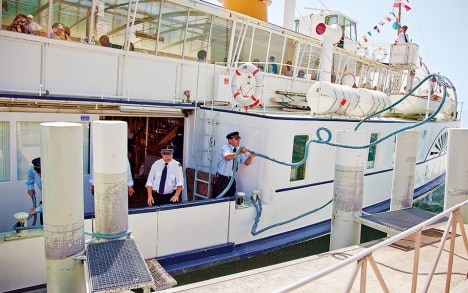
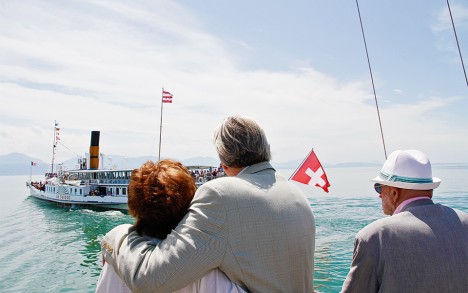
Today, these maneuvers are still quite A FEAT FOR THE FIVE STEAMBOATS.
be opened, to reduce the lateral surface presented to the wind.
Finally, the insidious lake undercurrents are the ultimate unknown, as their directions and speed are unpredictable! Saint-Prex is a charming medieval village on the Swiss side, where everything seems peaceful. However, “every helmsman who has ever tried to dock there has botched it at least once because of the current,” says the former captain. His successor recounts that one day when he was approaching Saint-Prex with a 50 km/h tail wind, he was pushed back by a current coming at him from ahead.
Another factor in the equation is the fact that, in shallow waters, it is smart to keep the boat at a low speed to prevent a wave from forming at the rear, so that the rudder will continue to do its job. Clearly, it is not just in watchmaking that people love complications.
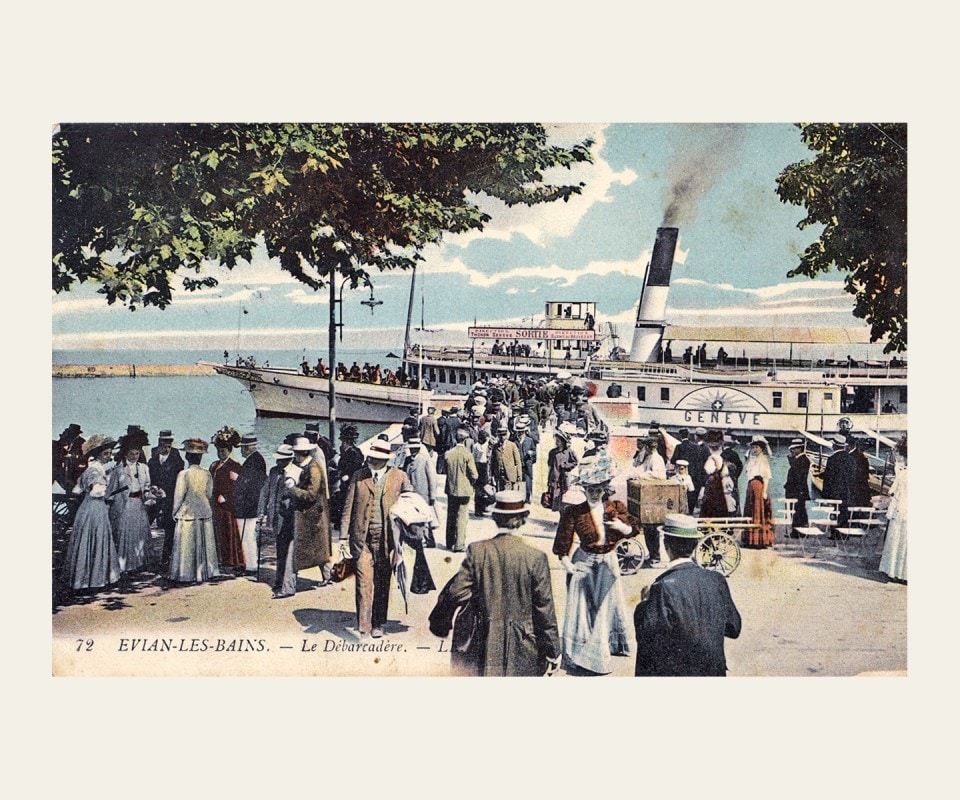
Boarding for Thonon, Nyon and Geneva aboard the two-deck steamboat Genève (built in 1896 and decommissioned in 1974) at the port of Evian-les-Bains one summer day in 1908. Postcard enhanced with artificial colors published by Levy & Neurdein Réunis. Collection Patrimoine du Léman – Didier Zuchuat.
And speaking of ingenuity, we really have to mention the clever trick used to dock near the Pont du Mont-Blanc (Geneva). Even if you do not see the spoon, sugar cube and square of chocolate used by First Captain Heymoz to demonstrate the maneuver, you will understand the explanation. Coming from the upper lake into the narrow Geneva harbor, the boat takes a wide berth to present facing the shore. Here, there is a sand and gravel bank where the captain deliberately runs up the bow (front) of the ship. Then, the current of the Rhône (which exits the lake at this point) does the rest of the work by turning the boat around the bow, “parking” it parallel to the shore.
Although in the 1960s, electric rudder controls were installed and can now be operated by the captain from the lateral bridges, prior to that, the helmsman turned his big mechanical drive wheel by hand, following the captain’s orders. Today, these maneuvers are still quite a feat for the five steamboats. Because, unlike diesel-powered ships, it is not the captain (nor his helmsman) who controls the engines! It is the engineer down in the hold, who, with no view of the outside, operates the controls. “Stop,” “astern”... we all remember the markings on the dials of the picturesque engine order telegraphs, which are still used to communicate between the bridge and the engine room, with an intercom if necessary.

The 1st class lounge-restaurant of La Suisse.

The main staircase of the Vevey.
We understand better how important the work of each member of the crew is: clear orders, an immediate reaction, and skill, as the former First Captain explains: “The maneuver is quite complicated for an engineer. He has to place his connecting rod in the right place. Otherwise, when he reverses the engine, it doesn’t start up, and he has to give it auxiliary steam. But during that time, the boat moves forward 5 or 10 m farther than it should have.”
By working so closely together, everyone recognizes the style of the others, even without seeing them. From his lookout station, the captain knows which of the two engineers just carried out his orders, based on how quickly he did so. Conversely, the engineer knows which captain or helmsman is performing the docking maneuver, depending on whether or not he uses the force of the wind.
LIVING BOATS
So how do the captains take into account all these factors? It’s impossible to calculate the result by entering the speeds and angles of the wind, waves and currents into a smartphone, all weighted by the mood of the engineer and the age of the captain. “We navigate a lot by feeling, you have to feel how the boat reacts, how it moves, it’s instinctive,” says First Captain Chenaux. He adds: “Our steamers are alive, we feel them, they breathe, the steam engine gives the boat a rhythm, it vibrates. The eccentric connecting rods create jolts. The sounds are important, for instance a certain type of steam noise tells you that the boat is not going to reverse immediately. A boat is not just a big machine, it’s complex, it’s alive.”
When asked which ship he prefers, he hesitates, as if worried that his protégés, moored less than 50 m away, might hear us. “Tricky question... it makes me a little sad to say: La Suisse is the most beautiful boat, but I prefer the Simplon; it is more lively, more spirited, even if it is the same size. La Suisse is much more sluggish.” His predecessor agrees: “We think of La Suisse as a lady and the Simplon as a male. It is more settled in the water.”
THE PARADE
Now held every year in spring, the naval parade of the Belle Époque fleet brings these thoroughbreds together for a ballet. From the moment you climb onboard the boat of your choice, all your senses are caught up by the show. You head out on the lake, into the wind, where you join the other ships that greet you with their steam whistles blowing. Steaming ahead at full speed just 15 m from neighboring boats, you see and hear their paddles churning, just as you feel your heart pounding when two opposing lines of ships rush forward, passing within a hair’s breadth of each other.

“The steel of these old ships has become brittle, it's more difficult to work with,” says one of the welders sent by the shipyard in Saint-Nazaire, France.

Chief engineer Markus Graf in front of “Joséphine”, his favorite steam engine.
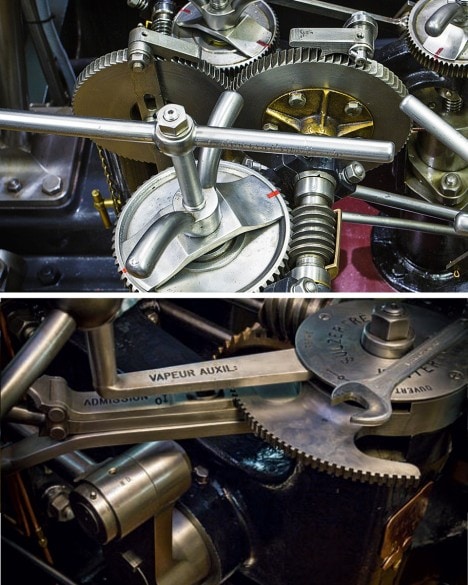
The ratchet pump is driven by the movement of the pair of cams that control the admission of steam into the high pressure cylinder. This ingenious geared device bears a resemblance to a clock. It lubricates inaccessible parts while the machine is running.
THIS CHOREOGRAPHY PERFORMED ON THE LAKE is all the more admirable in that there is no rehearsal.
But the most spectacular and most difficult maneuver takes place in slow motion. The boats meet face to face to form a star. Managing to stop the bows of these behemoths just a few meters from one another is a true exploit, even if there is no wind or current, which is rarely the case. It would be inaccurate to say that during this maneuver you could hear a pin drop in the cockpit, because “no one would dare to drop a pin”.
This lake choreography developed by First Captain Chenaux is all the more admirable in that there is no rehearsal. Depending on the weather, there is, of course, a plan B and even a plan C.
This show also exists thanks to the passionate people who work so hard to preserve the Belle Époque fleet, starting with the Association of Friends of the Lake Geneva Steamboats (ABVL) and the Pro Vapore foundation. They raised 12 of the 15 million francs needed to renovate (2007 to 2009) the flagship of the fleet, La Suisse. In 2003, with the support of the Musée du Léman, the Heritage Association of Lake Geneva (APL) restored the mahogany canoe at the ship’s stern and the figurehead, entirely covered in gold leaf. Subsequently, the structures, the equipment and the decoration of the boat were renovated.
Roughly a hundred kilometers of electric cables, honeycomb partitions and bow thrusters were used to upgrade the century-old boat. This grand old lady was painstakingly restored to her original splendor. What a pleasure for the eyes to caress the woodwork of the first-class lounge, made of moiré sycamore maple and enhanced with apple, pear and boxwood inlays. As you savor a glass of Dézaley, you will detect as many notes and essences in the wine as enchanting details in the woodwork.
If you switch boats for the trip back, you may see the neo-Directoire-style lounge of the Vevey, featuring chestnut wood inlaid with amaranth and ebony. The total renovation of this boat will be completed this fall. It has come a long way.
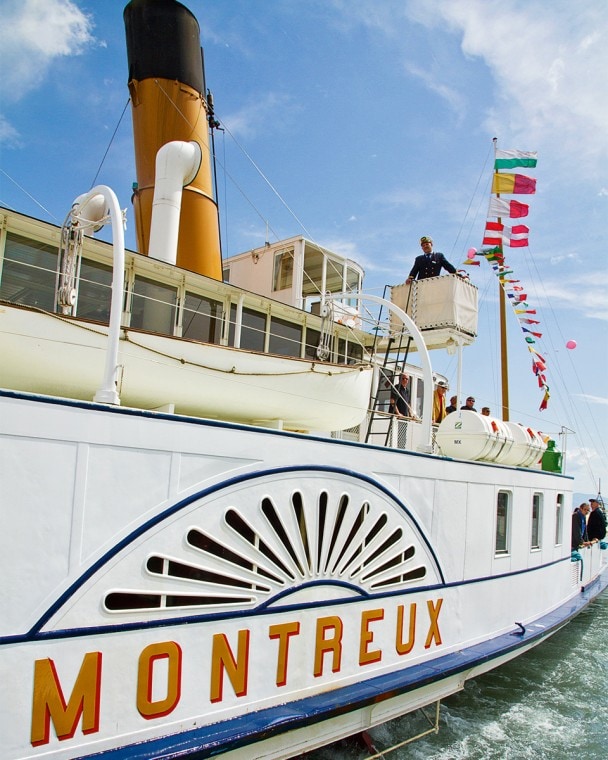
The star figure is the highlight of the naval parade and is also the most difficult to perform. It requires perfect coordination, not only among the ships, but also between each ship captain and his engineer, who must immediately carry out the orders he receives.

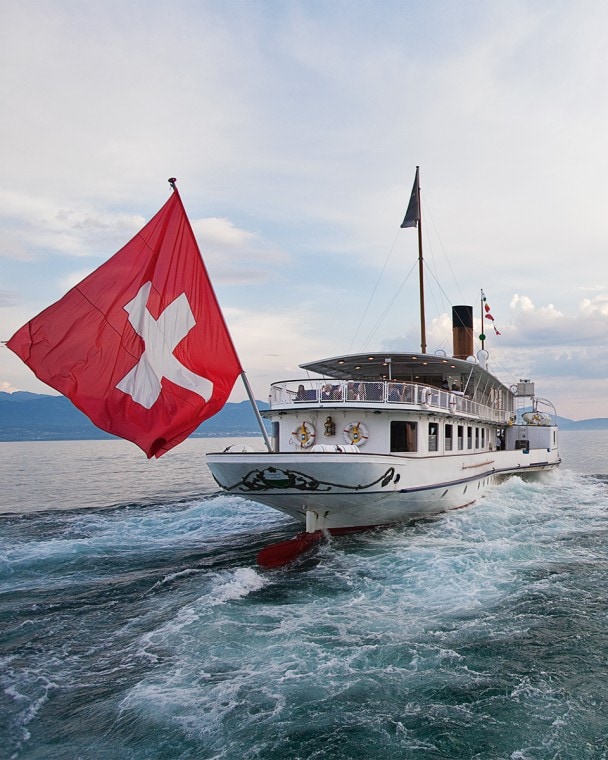
Its original shape has been brought back, with the small lounge re-created and the fireplace freed up. It has been artfully restored according to the original design, with a few concessions to safety, as in the case of the windows of the wheelhouse. Technology has been added as well, making it possible to control the heating and the level of the storage tanks from a smartphone!
Two other boats are still awaiting renovation, first the Italie, then the Helvétie. The ABVL raised one third of the 12 million francs needed for the former.
When asked what he wishes for the future of the Belle Époque fleet, First Captain Chenaux answers without hesitation: “For it to continue to be included in the regular schedule so that everyone can enjoy the boats and so they don’t become museums.” There’s no point in asking him to recount his navigational feats. He prefers to talk about what he sees from his “citadel,” be it funny-shaped clouds or droll flocks of squabbling birds. He may also mention the almost magical vision of rowers on the lake, only their heads visible above a shroud of fog. Or the memory of a little blind boy who discovered the cockpit (wheelhouse) by feel. “He had a huge smile on his face, he was so incredibly happy.”
This affinity for nature and people seems to be a common trait of the two First Captains: “I always told the guys I trained: ‘Watch, look and listen. That’s what counts!’” says Aldo Heymoz. He adds, “I’ve always lis- tened, even to someone who’s brand new in the wheelhouse. I always figured that maybe there was something I could learn.”
These admirals of Lake Geneva are truly modest.
--------------------
USEFUL INFORMATION
The Lake Geneva Belle Époque boats operate from April to October: www.cgn.ch
Association of the Friends of Lake Geneva Steamboats: www.abvl.ch
Lake Geneva Heritage Association: www.patrimoine-leman.ch
“Steam navigation on Lake Geneva 1841-1941”, exhibition from April 28, 2013, to January 5, 2014; Musée du Léman in Nyon: www.museeduleman.ch
C. Bertola and D. Zuchuat, L’Âge d’Or de la navigation à vapeur sur le Léman 1841-1941, Éd. Glénat, Nyon, 2013
Journal of THE LAST CRUISE OF THE M/S VEVEY
September 30, 2010, 6:14 pm: Cully en Lavaux. It’s unusual, the Vevey arrives late.
Although it has traveled 3 million kilometers since its inauguration, it doesn’t seem out of breath. And yet, it will be decommissioned in a few days. There is not enough money to pay for its renovation.
6:17 pm: Departure, hands wave, for once it is the boat that’s being saluted.
7:46 pm: In the first-class lounge, a lady dressed in Belle Époque finery smiles.
7:57 pm: Landing at Saint-Prex. The mariners have switched on the hazard lights, whose bright glare turns the whole boat red; the Vevey’s steam whistle blows. On deck, protected from the drizzle by a hood, a lady calmly drinks her tea.
9:00 pm: The last passengers debark in Lausanne. Only the families and friends of the crew remain on board.
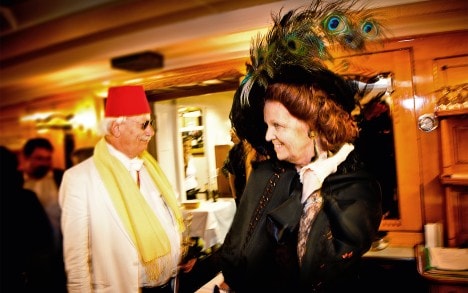
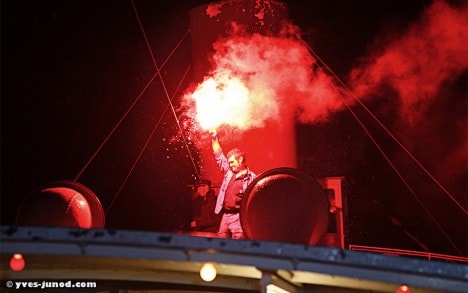
9:52 pm: The Vevey has arrived at its home port. Captain Schaffner comes down from the lookout, looking serious.
10:01 pm: Engine room. The captain hugs his engineer, who could not bring himself to turn off “his” engine. The captain does it for him.
11:17 pm: All the energy has returned and in the first-class lounge, people are laughing and dancing to Smoke on the Water.
12:05 am: I leave the crew to continue their celebration. On the platform, a crayfish, which probably fell out of a fisherman’s net, waves its claws; I put it back into the water. It is still alive.
Epilogue. March 5, 2013, 11:42 am: Bellerive (Lausanne) shipyard. Like the Phoenix, the Vevey is reborn under the sparks of the welding torches. It was saved by a government decision. In a few months it will sail again.

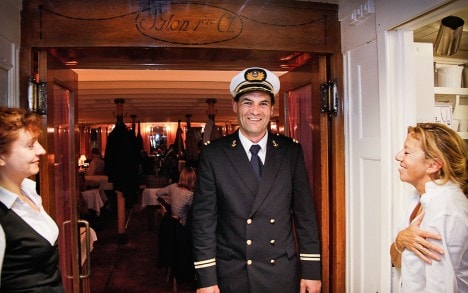
“Joséphine”, “Béatrice” and “Sophie” ... THE STEAMSHIP ENGINES
These are the names given to the engines of three of the five steamers, respectively the Savoie, La Suisse and the Simplon. Like captains, engineers have their preferences, and too bad for the Montreux with its modern steam engine and for the Rhône whose engine has not attained the perfection of its elders.
They may have beautiful girls’ names, but these machines are more reminiscent of the cycling champions of the Tour de France. The engine room is open at the top, so passengers can enjoy watching the two connecting rods pump up and down and listen to the engines pant as they rev up to full power. And what power! La Suisse delivers 1,400 hp allowing it to propel its 513 t and 78 m at a cruising speed of 25 km/h, to the delight of 850 passengers(maximum).
Obviously, this champion gets quite thirsty, gulping down 20 l of fuel per kilometer on average. In comparison, the diesel engine of another Belle Époque paddle steamer, the Vevey (64 m and 297 t), consumed 8 l (before the renovation in progress).
The engines of the three aforementioned thoroughbred steamers were built on the same model, by the Swiss company Sulzer Brothers. It is a compound system consisting of two cylinders, one high pressure (small volume), the other low pressure (large volume). The steam enters the firstcylinder at a temperature of 280-300 °C and a pressure of 10.5 bar, where it drops to 1 bar, before moving into the second cylinder, which uses it up to 0.3 bar to activate the second rod.
But don’t let these numbers and the pictures of the massive components fool you into thinking that these machines are brute beasts. It is pure watchmaking at its finest: although the largest bearings are 240 mm in diameter, they have only 0.2 mm of clearance. Precision to 1/1,200! A tenth of a millimeter too little, and the rod heats up, three tenths too much, and it hits.
This precision machining requires extreme care. Like champions, these machines are regularly massaged with oils. Out on the water, this is a full-time job for the assistant engineer who is responsible for some 150 lubrication points, which he inspects in turn every 80 minutes. It takes no less than 15 l of oil per day to lubricate the cylinders and 10 l for the moving parts.
Just one more number and you will know everything there is to know about these cyclists that ply the lake: their two paddle wheels have a diameter of 3.4 to 3.7 m, and, thanks to an eccentric system, their blades enter the water at an optimal angle.
